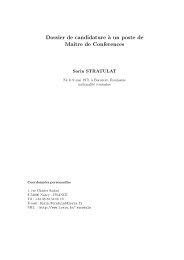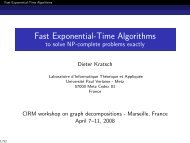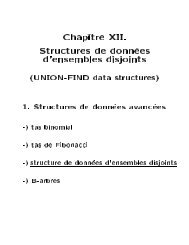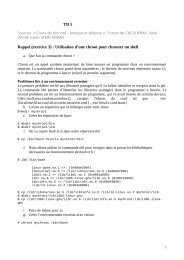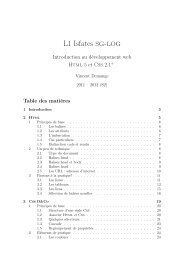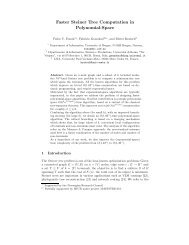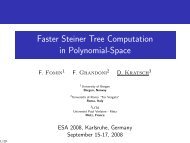Iterative Compression and Exact Algorithms - Lita
Iterative Compression and Exact Algorithms - Lita
Iterative Compression and Exact Algorithms - Lita
You also want an ePaper? Increase the reach of your titles
YUMPU automatically turns print PDFs into web optimized ePapers that Google loves.
d #MHS d MHS d2 O(1.2377 n ) [26] O(1.2108 n ) [24]3 O(1.7198 n ) O(1.6278 n ) [26]4 O(1.8997 n ) O(1.8704 n )5 O(1.9594 n ) O(1.9489 n )6 O(1.9824 n ) O(1.9781 n )7 O(1.9920 n ) O(1.9902 n )Table 1: Running times of the algorithms for #MHS d <strong>and</strong> MHS d .In the second case, there exists a hitting set of size αn. Then countall minimum hitting sets using the compression algorithm of Lemma 6 withH being a hitting set of size αn found by the enumeration phase. ByLemma 6, this phase of the algorithm has running time O ∗ 2 αn a n−αn d−1 .The best running times of algorithms solving #MHS d <strong>and</strong> MHS d are summarizedin Table 1. For #MHS ≥4 <strong>and</strong> MHS ≥5 , we use the algorithm ofTheorem 11. Note that the MHS 2 problem is equivalent to MVC <strong>and</strong> MIS.Finally, it is worth to note that the technique can also be used to solve theparameterized version of d-Hitting Set. Namely, we consider the followingproblem:(k, d)-Hitting Set (k-HS d ): Given a universe V of n elements, acollection C of subsets of V of size at most d <strong>and</strong> an integer k, findahitting set of size at most k of C, if one exists.Theorem 12. Suppose there exists an algorithm to solve k-HS d−1 in timeO(a k d−1 · nO(1) ), where a d−1 ≥ 1. Then k-HS d can be solved in time O((1 +a d−1 ) k · n O(1) ).Proof. The proof is very similar to the one of Theorem 8 except that thesize of a solution is now bounded by the parameter k instead of n. GivenauniverseV = {v 1 ,v 2 ,...,v n } <strong>and</strong> a collection C, for i =1, 2,...,n,letV i = {v 1 ,v 2 ,...,v i } <strong>and</strong> C i = {X ∈ C | X ⊆ V i }. Then I i = (V i , C i )constitutes an instance of k-HS d for the i th stage of the iteration. Wedenote by H i a hitting set of size at most k, if one exists, of the instance I i .Clearly, if {v 1 }∈C,thenH 1 = {v 1 } (assuming that k ≥ 1); otherwiseH 1 = ∅ <strong>and</strong> h 1 = 0.Consider now the i th stage of the iteration. The relation |H i−1 |≤|H i |≤|H i−1 | +1≤ k + 1 holds since at least |H i−1 | elements are needed to hit allthe sets of I i except those containing element v i <strong>and</strong> H i−1 ∪{v i } is a hittingset of I i .10



